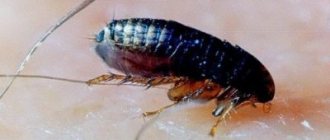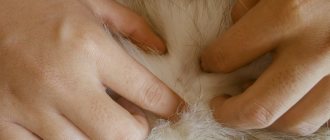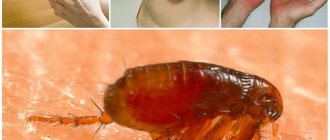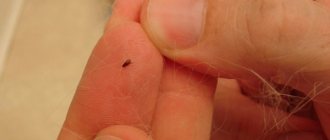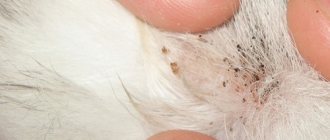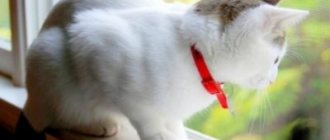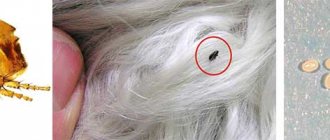In the ranking of the most common parasitic infections in cats, fleas lead by a wide margin. They are found both in pets that walk frequently and in couch potatoes.
In order to avoid the dangerous consequences of a flea infestation, owners must know how to determine that a cat has fleas and what steps to take to quickly remove the annoying bloodsuckers.
Fleas in cats: appearance, description
Fleas in cats, features of the parasite
Fleas are a large order of insects, which includes different subspecies: insects that feed on the blood of cats, dogs, rats, moose, people, etc. Parasites differ not only in their diet, but also in size, chitinous color and body structure.
The cat flea is one of the most common types. It is small in size - up to 3 mm. Females are larger than males because they carry eggs in their abdomens.
The flea has a laterally flattened body and long hind legs; thanks to this structure, the flea moves quickly through the fur.
The flea has two dark eyes and short antennae on its head. The mouthparts are of a sucking-piercing type, adapted for piercing the skin of an animal and sucking out blood. The insect has a voluminous abdomen, which increases significantly during feeding.
The flea's entire body, limbs and head are covered with bristles and spines; they are needed so that the insect can stay on the animal's body.
The flea has two claws at the ends of its legs, with which it moves through thick fur. The flea has well-developed hind legs; they consist of five segments, so it can jump over a distance of up to half a meter. The front legs are shorter.
Cat fleas can range in color from light tan to almost black. There are light stripes on the insect's abdomen.
Products for removing fleas from domestic cats at home
To combat cat fleas and other external parasitic organisms, pharmacology produces various forms of insecticidal agents: drops, shampoos, collars, tablets and injections. The choice is made based on the age, physiological state of the cat, as well as taking into account the individual characteristics and general health of the pet.
Shampoo
Shampoos with anti-flea composition are not highly toxic and can be used to treat small kittens, unlike other products with similar effects. The product is especially suitable for animals with thick and long hair. The shampoos contain specially selected substances - insecticides, which have a detrimental effect on both adult insects and insect larvae. The shampoo contains extracts of medicinal herbs with anti-inflammatory effects that eliminate itching and swelling at the site of bites. Almost all detergents for cats are hypoallergenic.
Popular detergents with anti-flea action include:
- Phytoelite;
- LEOPARD;
- Lugovoy;
- Celandine;
- Bio Thunder.
A small amount of shampoo should be distributed evenly over the cat's wet fur and lathered thoroughly. You need to be careful with the ears; not a drop of water should get into them. It is safer to dissolve the product in 100 ml of water and apply the resulting solution to the cat’s skin. After rinsing off your pet, you need to dry it with a dry towel. The procedure must be repeated after a few days. It is not recommended to use such products frequently, as this can lead to the accumulation of toxic substances in the pet’s body.
Injections and tablets
Injections are used when a cat is heavily infested with insects. The drugs Ivermectin, Eprimek, Lufenuron are administered. They protect against bloodsuckers for 6 months. The injection must be given by a doctor in a veterinary clinic, since these drugs have a number of contraindications.
To destroy parasites, drugs are used in tablet form, in particular Comfortis, Lufenuron. The preparations are based on insecticides that are safe for cats and harmful to insects. They also resort to using this product if the animal has dermatitis, when external agents are practically impossible to use. Fleas die within 30 minutes after taking the tablet. The disadvantage of this method is the likelihood of an allergy in the cat as a result of taking insecticides.
Drops
Drops on cats' withers help destroy fleas and protect the cat from bloodsuckers for 2-3 months, depending on the manufacturer. The packaging of the product comes with a special pipette, which is used to apply drops to the cat’s withers. The death of parasites occurs within 24 hours after application. The following drugs are in demand: Rolf Club ZD, Barrier, Dana Ultra Neo, Inspector, Advantage, Stronghold.
Collars
Collars can be purchased at any pet store. The remedy is more preventative than curative. The collar protects the animal not only from fleas, but also from dangerous ticks and mosquitoes. If the cat has a free range, the collar will protect it from various parasites.
The collar is put on a clean pet after fleas have been eliminated. It protects against insects for several months. When choosing, it is important to pay attention to the production time and date. The fresher the collar, the more effective it is. It is necessary to check the integrity of the foil packaging, since a violation of the seal affects the properties of the collar.
You need to choose collars from well-known companies; the price of branded products may be higher, but the quality of such companies is guaranteed. You can't buy dog collars for cats. If you are choosing a collar for a small kitten, you need to check its purpose on the packaging.
Bars, Celandine, and Beafar collars are in great demand among consumers.
Sprays
Sprays are an effective way to control fleas. The drug is sprayed onto the cat's fur, causing the death of insects. Sprays must be used strictly according to the instructions. Do not allow the product to get into your pet's eyes. It is advisable to process wool in the fresh air or in a well-ventilated area. Cat owners most often prefer Frontline, Delix, Bars sprays.
Reproduction and life cycle of fleas
Fleas are incredibly resilient: they can go more than a year without eating. In addition, insects reproduce quickly: they can lay up to 300-400 eggs per day. The eggs do not have a sticky substance, so some of them get stuck in the animal's fur, while others fall to the floor. In addition, females lay eggs in floor crevices, upholstery and other secluded places.
On average, the development cycle takes two weeks.
Flea eggs are white and oblong in shape, approximately 0.5 mm long. The eggs hatch into larvae.
Flea larvae look like worms, they do not have eyes or legs, they are dark in color, and also have segments and sparse bristles on their body. The larvae are small in size: their length does not exceed 6 mm, and their thickness is 1-2 mm. While adult fleas live on an animal’s fur and feed on blood, the larvae live outside the animal’s body and can usually be found in the upholstery of upholstered furniture, carpet pile and floor cracks.
Features and signs of fleas in a cat
Unfortunately, not only fleas, but also other types of insects (ear and ixodid mites, lice, lice, coccidia) can pester cats. Therefore, it is important to distinguish these particular parasites and immediately begin removing them.
Fleas are brown, blood-sucking insects, approximately 2mm in length, that can be found in an animal's fur. A characteristic feature of fleas is their ability to move very quickly; the jumps of these parasites over long distances are difficult to notice with the naked eye. Unlike lice eaters, fleas attach themselves to the skin of animals, and not to the fur itself. In addition, lice eaters do not have the ability to jump. You can distinguish a flea from a tick by the number of legs; ticks have 8, while a flea has only 6. The photo shows a tick, a louse, a bedbug and a flea; their differences are visible on it.
You can recognize the presence of fleas in domestic cats by a number of signs:
- restless behavior;
- frequent itching and irritation of the skin;
- the appearance of worms;
- an allergic reaction is possible;
- the presence of small red dots at the bite sites;
- decreased appetite.
How can you tell if a cat has fleas?
It is quite easy to determine that blood-sucking parasites have appeared on your pet’s body, since the symptoms of fleas in cats are quite specific. Animals begin to constantly itch, rub against the corners of walls, furniture and the floor, try to comb out and gnaw parasites out of their fur, they become restless.
The condition of the coat deteriorates. It becomes faded, the hair begins to fall out, and bald patches appear. Scratches and abrasions form on the skin.
If these signs appear in your cat, then it is necessary to examine the animal’s fur; there should be small wounds, combed areas, excrement on it, and you may also notice fleas themselves. They usually hide in places that are difficult for a cat to reach: near the ears, on the neck, chest, armpits or back.
When examining, you need to be as careful as possible. Owners often confuse fleas on cats with grains of dirt stuck in their pet's fur. Of course, if they start to move around, it becomes obvious that they are parasites and not dirt. Flea droppings are also not easy to identify because they are mistaken for insect eggs. Especially a lot of insect waste products can be found in long and thick hair; in short-haired cats they are more often combed onto the floor.
If fleas in cats are not detected in time and appropriate measures are not taken, the pet will suffer greatly, because up to 200 fleas can live on one animal!
Cat fleas can also be found on kittens.
Fleas in cats, main signs
Fleas in cats, example of infection
First symptoms of infection
Only an attentive owner can notice the first symptoms of infection. The pet begins to itch intensely. Fleas try to stay in places that are difficult for a cat to reach: on the back, near the ears, in the armpit, on the skin in the chest and neck area of the body.
A visual inspection reveals traces of flea activity in the form of small black dots. White flea eggs are found in the pet's sleeping area. Cats often develop an allergic reaction to flea bites, which is explained by the presence of a toxic substance in the insect's saliva.
The first symptoms are a fairly serious reason to start treating your pet, since a neglected condition is fraught with serious consequences, since parasites multiply very quickly.
Second stage
Since insects reproduce quite quickly, the disease can progress to the second stage in a short period of time. This phase of the disease is revealed by the cat’s expressed anxiety. The pet is nervous, constantly meows, bites itself, trying to destroy the parasites. The furry animal loses its appetite, refuses its favorite foods, and sleeps poorly.
At the second stage, the number of fleas reaches 200 pieces. By parting the fur, you can easily see the parasites. The animal's body is covered with bites, scratches, and bleeding wounds.
Progressive disease
Without treatment and the necessary care, the disease progresses, turning a cheerful, playful cat into a nervous and irritated creature.
The cat begins to lose weight sharply, as it practically does not eat. The condition of the coat changes. It falls out in shreds, and bald spots appear in some places. Cats are sensitive to allergens, and insect saliva contains a toxic substance that causes allergies in most pets. As a result of flea bites, an animal may develop allergic dermatitis. The condition is extremely dangerous and the pet must be saved immediately. The presence of a large number of fleas can lead to the death of a cat.
Flea infestation is especially dangerous for small kittens, who begin to rapidly lose weight. Most kittens develop anemia; in advanced cases, the cat may die.
How dangerous are fleas for a cat?
The presence of fleas causes severe discomfort. Because of their bites, the animal begins to itch severely and often scratch the skin, resulting in abrasions. Because of this, the cat may develop allergic dermatitis. In trying to comb out insects, a pet can damage the skin, and there is a possibility that an infection will get into the wounds, which will lead to inflammatory processes.
Fleas are carriers of worms, as well as various dangerous viruses, which they can transmit through the blood to an animal or even a person.
Fleas are especially dangerous for kittens, elderly pets and animals with weakened immune systems. They can also harm a pregnant cat's future offspring. If the mother is infected, the kittens will be infected at birth.
Despite its small size, one flea can drink a fairly large amount of blood. A kitten infected with these parasites may become anemic, and severe damage can be fatal.
Cat fleas are also dangerous because they can bite people. Of course, parasites prefer animals, but if they want to eat and there are no pets nearby, then they can attack humans. In addition, the likelihood of people being bitten increases if there are too many fleas in the house.
Are cat fleas dangerous to humans and are they transmitted?
A flea can attack anyone (including humans) who is nearby, although it has certain preferences. An attack on a person is possible when the premises are heavily infested with insects and in the absence of a pet as a source of food.
Fleas from cats are not transmitted to humans in the literal sense of the word. Insects only feed on the blood of animals and will not live on humans. They can migrate from place to place by jumping onto clothing when a person passes near their habitat or while petting an infected cat. Fleas can move into the folds of clothing when a person comes into contact with the belongings of animals infested with insects.
Not only flea bites pose a danger to humans, but also the fact that insects are carriers of various diseases.
A flea bite in a person can cause:
- Skin rashes that can lead to the development of mass dermatitis;
- Food poisoning due to fleas ingesting food;
- Various infectious diseases, in particular brucellosis. The disease is characterized by damage to internal organs, fever, and often ends in death;
- Creeping erythema. The disease is revealed by the constant occurrence of dead ulcers, as a result of which the skin begins to peel off and turn pale;
- Severe allergies. The pathological condition is accompanied by fever, shortness of breath, and can lead to anaphylactic shock;
- Anthrax. The patient experiences hematomas, damage to internal organs, erosion, and general intoxication of the body. The disease is fatal.
You can prevent flea attacks by regularly wet cleaning the house, wiping the dust, and washing dirty laundry, since it is in dust and piles of garbage that insects live and their larvae develop.
Why might a cat get fleas?
The reasons for the appearance of fleas in cats can be different, and parasites can settle both on pets that walk daily and on domestic cats. In the first case, the most common reason for fleas settling on a cat is contact with an infected animal.
As already mentioned, even if your pet is not outdoors, there is a possibility that he may have fleas. Larvae can enter a house on a person’s shoes, through cracks in ceilings and through the threshold of the front door. Despite the fact that one flea will not drink much blood from an animal, it can quickly multiply, and this will lead to serious problems.
Fleas can enter the house through various household items that have eggs or larvae of parasites, as well as from neighboring apartments where there are infected animals.
Often fleas get onto the body of pets through the owner who stroked an infected cat on the street.
Even a newborn kitten can have fleas if its mother was infected.
How to protect cats from fleas?
Washing your cat can help prevent fleas.
It is always easier to prevent the appearance of parasites than to treat them. The ways in which fleas get into the house were listed above; in order to protect your pet and yourself from fleas, you must carefully monitor the hygiene and cleanliness of the house. You need to periodically wash your outerwear, wash your cat if it is outside, wash the floors at home, and wipe off the dust.
You can avoid the appearance of parasites with the help of special repellent drugs and collars. They must be used if your pet regularly walks.
Pet stores have flea-repellent collars for cats of different brands: from budget to expensive. Well-known brands are “Clandestine”, “Bars”, “Hartz”, “Ceva”, “Virbac”, etc. The essence of the action of anti-parasitic collars is simple: they contain a special parasite-repellent agent that covers the animal’s fur.
But such a collar has disadvantages, in particular, it contains toxic substances that can cause allergies. In addition, such collars have a limited lifespan, so they must be changed periodically.
If preventive measures do not help, and the animal has fleas, then treatment will be required not only for the cat itself, but also for the house in which it lives.
Prevention
There are a great variety of cat parasites in nature, but there are several rules that, if followed, will reduce the risk of infection by a pet owner by up to 90%.
Fleas on a cat: what to do and how to get rid of fleas at home, read more in this article.
- Disinfection of a pet's sleeping place. Using special detergents or adding dectar soap when washing.
- Daily cleaning of food and water utensils with cleaning agents. Soda is suitable for these purposes.
- Your pet's diet should be regular and balanced.
- Systematic treatment of animal fur with special anti-flea agents.
Important! Veterinarians recommend disinfestation at least once every three months. And the body of cats that love to walk outside should be treated with anti-flea drugs at least once a month.
How to get rid of fleas on cats?
To cure a cat and rid it of parasites, you need to treat the pet itself, as well as the house where it lives.
Treating cats for fleas
At a pet store or pet clinic, you can find a wide selection of products based on insecticidal or repellent substances that help get rid of fleas. They are available in different forms: shampoos, sprays, drops and tablets.
Products can cause an allergic reaction, so it is better to test them on a small area of skin first.
You should not use several products with different active substances, because even individually they cannot be called safe, and together they can be too toxic and cause harm to the animal.
Flea shampoos
Flea shampoo is a popular and effective way to get rid of parasites. It can kill fleas in just one use! These drugs have a fairly safe composition and also protect cats from re-infection for a long time. Since such products contain aggressive substances, it is necessary to ensure that the shampoo does not get on the mucous membranes of both the pet and the person carrying out the treatment. Sometimes using shampoo is difficult, because it is known that not every cat likes water treatments.
Popular flea shampoos are the brands “Clandestine”, “Lugovoy”, “Bars”, “Fitoelita”, etc.
Flea sprays
Flea sprays are also quite effective. When using them, you need to cover your face with a gauze bandage and wear gloves to protect yourself from exposure to active substances. The cat should also be protected with a special collar, in which case it will not be able to lick the drug from its fur. This measure will protect your pet from poisoning and will also enhance the effect of the spray. It is also recommended to cover the cat's eyes, nose and mouth while spraying.
Sprays are more effective for smooth-haired cats. For pets with long hair, the product may remain on the fur without getting on the skin.
In stores you can find flea sprays of the following brands: “GreenFort”, “Bayer”, “Virbac”, “Merial”, “AVZ”, etc.
Flea drops
The easiest to use and effective remedy is flea drops. It is enough to apply them to the animal’s withers. The drops will not only help get rid of fleas, but will also protect the cat from re-infection, since the active components of the drops will enter the bloodstream and penetrate the entire surface of the skin, killing parasites.
The advantage of the drops is that there is no need to close the airways; in addition, the cat will not have to wear a collar, since the drug will be in a place that is difficult for it to reach.
Drops such as Frontline, Delix, Barrier, Advantage, Celandine, Inspector, etc. are considered effective.
Flea tablets
Flea tablets are a more radical method of treatment, so you should resort to it after seeing a veterinarian. The effectiveness of the tablets is ensured by the fact that the active components enter the bloodstream, spread throughout the body, and when a flea bites a pet, these substances enter its body and kill it.
The tablets can be placed in the cat's food or placed on the back of the tongue, stroking the pet's throat to trigger the swallowing reflex. Tablets can be given to a cat from a certain age (from about 3 months).
The most popular flea tablets are Comfortis, Capstar, etc.
Flea vaccination
A new way to control fleas is vaccination. But this method is an aggressive measure, so it cannot be used on pregnant or lactating cats. The advantages of vaccination are its high efficiency and long duration of action, which prevents re-infection.
How to get rid of fleas on kittens?
We have highlighted the treatment of kittens as a separate item, since it has its own characteristics. Babies up to two months old are cared for by their mother: she feeds them with her milk and also licks them. Kittens should absolutely not be treated with shampoos, sprays and flea drops, as the cat will lick them off, and then harmful substances will enter the babies’ bodies through the milk.
But if all means are prohibited, then what to do? In this case, mechanical methods of flea control are suitable. Of course, they are less pleasant, the procedures take a lot of time, but there is no danger for kittens and a nursing cat.
The following mechanical methods can be used to control fleas in kittens:
- catching fleas by hand;
- combing out parasites with a special comb.
It will not be possible to get rid of fleas at once, because using such methods it is impossible to remove all the fleas and their eggs at once. You can increase the efficiency of treatment and speed up the process of getting rid of fleas by bathing kittens in baths with herbal decoctions. Rosemary and wormwood will be especially effective.
In pet stores you can find shampoos for younger kittens, but keep in mind that they can only be used if they are weaned from their mother.
For babies who, for some reason, are left without a mother, special anti-flea sprays and powders are also suitable. The powder should be applied with your fingers and rubbed into the kitten's skin, while making sure that the baby does not lick it off.
Spray for kittens should not be immediately sprayed onto the kitten's fur; it is better to apply it on the palms of your hands and then distribute it over the hair. Afterwards, you need to make sure that the kitten does not lick the drug, and you also need to wash your hands thoroughly.
When the kitten reaches 3 months of age, regular cat products can be used.
Treating your home for fleas
There is a misconception that fleas live on the animal’s fur all the time; in fact, they only feed while on the cat; the rest of the time, the parasites hide in the upholstery of furniture, cracks in the floor, walls, etc.
For this reason, disinfestation of the house is a mandatory stage in treating an animal for parasites. Even if there are no fleas left on his fur, there is no guarantee that they are not hiding somewhere in the house, so it is important to thoroughly clean the home.
It is necessary to vacuum all carpets and upholstered furniture. Particular attention should be paid to the animal’s personal belongings: bed, toys, etc.
The house should be treated with special anti-flea products: powders, solutions and aerosols. Before using them, you must remove all food products; if you have an aquarium, you should cover it and turn off the filter during processing.
When cleaning, you should wear gloves and a protective mask; after work, it is recommended to ventilate the room for 2-3 hours; this time is best spent outside the home.
Shampoos
Shampoo treatment is effective, but it also has disadvantages: it is labor-intensive and time-consuming.
The shampoo must be diluted in water according to the instructions and poured into a container with a spray bottle. Next, you need to spray the product in places where insects accumulate. To increase cleaning efficiency, we also recommend washing the floors by adding flea shampoo to the water.
When working with shampoo, you need to put on gloves, cover your face with a protective mask, and remove all personal belongings and food.
Powders
Powders have a longer lasting effect than aerosols, but they are more difficult to process.
Powders are scattered or sprayed indoors, special attention should be paid to places where fleas may live, namely:
- corners of rooms;
- the space behind the baseboards;
- hard-to-reach places (the floor behind cabinets, sofas, beds, etc.);
- cracks in the floor.
Aerosols
With these products, you can completely get rid of fleas in two treatments. It is necessary to carry out the procedure several times, because the aerosol does not affect eggs and pupae.
Aerosols have a harmful and toxic composition, which, if it comes into contact with human skin or enters the body through the respiratory system, can cause harm.
Another disadvantage of aerosols is the need to prepare the home before treatment.
Fleas in cats are a common occurrence; parasites can even appear in pets. To get rid of them, you need to treat not only the animal, but also the house where it lives. There are special products that will help protect your cat from fleas; they are recommended to be used if your pet regularly spends time outside.
Flea control products
If a domestic cat has fleas, you must first choose the right product to remove them and treat the animal with it. And only after that the room should be cleared of parasites.
Today there are many effective anti-flea products. All of them can be divided into several main types:
- Flea collars are the most effective for preventing cat infestation. It is convenient to put such a collar on a cat that only occasionally goes outside for a short time. In this case, the product will effectively repel parasites. The disadvantage of collars is that they can cause irritation on the animal's neck. The most famous collars are Hartz, Beaphar, Bolfo.
- Insecticidal drops on the withers are an effective remedy for both killing and repelling fleas. They are very easy to apply - they just need to be rubbed into the animal's skin to protect it from parasites for several weeks - but can be toxic. Advantix, Stronghold, Hartz drops are very effective.
- Flea shampoos are the best product for cats. They have a very mild effect, are non-toxic, and effectively destroy the parasites already present on the fur. Fleas in a pregnant cat are almost always removed with the help of shampoo. Quite popular shampoos are Celandine, Fitoelita, and Lugovoi.
- Flea sprays are the most radical and quite toxic remedies. They are used when there are too many fleas on an animal and they need to be eradicated quickly and immediately. They require very strict adherence to the instructions and have many contraindications. For example, fleas on a nursing cat or kittens should not be removed with any of these products.
- Mechanical methods of flea removal: combing and catching fleas by hand. A very labor-intensive and time-consuming method. But, for example, in kittens under the age of one month, only with its help can you get rid of parasites.
In general, if a cat has fleas for the first time, choosing a remedy can be quite difficult, because it is not always possible to predict whether it will cause an allergy or not. Here it is not advisable to act by trial and error, but it is better to immediately consult a veterinarian.

